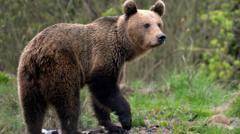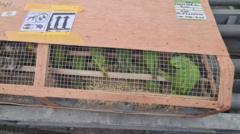A motorcyclist's life was cut short by a bear attack in the Romanian mountains, raising urgent questions about wildlife management and public safety in the region. The event occurred on a well-known stretch of the Transfagarasan road, popular with tourists. After stopping to take in the sights, the victim was dragged down a steep ravine by the bear. Ion Sanduloiu, head of the Arges County Mountain Rescue Service, reported that the injuries sustained were fatal, even with the rider donning a helmet and protective gear.
Fatal Bear Attack Highlights Concerns Over Wildlife Management in Romania

Fatal Bear Attack Highlights Concerns Over Wildlife Management in Romania
A tragic incident in Romania underscores the growing risks of human-bear interactions amid increasing bear populations.
The bear has not yet faced euthanasia as the investigation continues. Romania hosts the largest population of brown bears in the EU, with estimates ranging from 10,400 to 12,800, a figure significantly higher than previous counts. This increase has led to a rise in human-bear encounters, prompting calls for improved regulations around wildlife management.
Former environment minister Mircea Fechet noted that sustainable bear population levels should ideally be closer to 4,000. He has recommended measures allowing local authorities to more swiftly address bears encroaching on populated areas. Efforts are also underway to develop risk zone maps to better balance conservation and public safety.
Gabriel Paun, founder of the environmental NGO Agent Green, argues that the tragedy highlights deeper issues of wildlife management rather than simply an overcrowded bear population. He emphasizes the need for improvements in local and national strategies for preventing human-wildlife conflicts. With Romania becoming increasingly attractive to trophy hunters and facing challenges such as climate change and habitat destruction, the need for effective wildlife preservation measures is more pressing than ever. Sanduloiu advocates for stronger penalties against those who endanger both themselves and the bears through reckless behavior, calling for higher fines and potential prison sentences for those who feed bears.
Former environment minister Mircea Fechet noted that sustainable bear population levels should ideally be closer to 4,000. He has recommended measures allowing local authorities to more swiftly address bears encroaching on populated areas. Efforts are also underway to develop risk zone maps to better balance conservation and public safety.
Gabriel Paun, founder of the environmental NGO Agent Green, argues that the tragedy highlights deeper issues of wildlife management rather than simply an overcrowded bear population. He emphasizes the need for improvements in local and national strategies for preventing human-wildlife conflicts. With Romania becoming increasingly attractive to trophy hunters and facing challenges such as climate change and habitat destruction, the need for effective wildlife preservation measures is more pressing than ever. Sanduloiu advocates for stronger penalties against those who endanger both themselves and the bears through reckless behavior, calling for higher fines and potential prison sentences for those who feed bears.


















